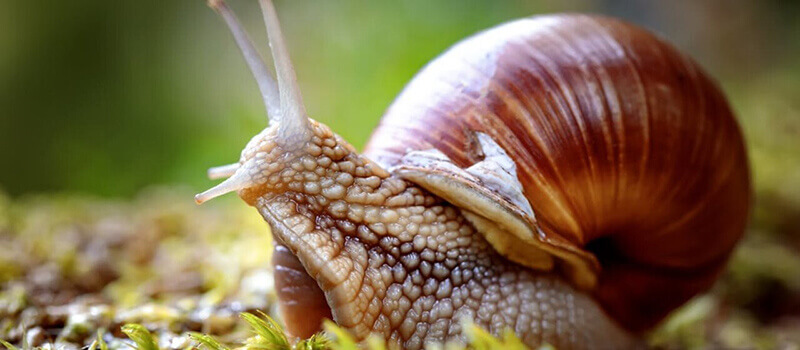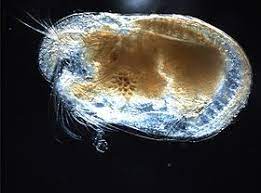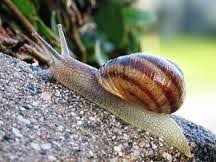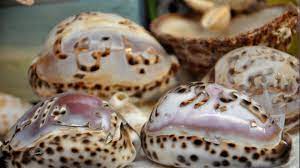


are the second largest phylum of invertebrate animals . It is divided into seven sects , the most important of which are shellfish , snails or gastropods , cephalopods - most of the marine animals of this sect live in fresh water - bipedal , copepods, and monophyletic. Galania. All mollusks have some distinctive characteristics that arose in different ways in the various groups, namely:The foot:
It is an organ located in the lower or ventral part of the body. It is composed of a muscle mass. It is the organ of movement in moving mollusks.Cloak:
It is a skin fold that surrounds the body, and between it and the body there is a cavity called the mantle cavity, which contains the gills .The shell:
is secreted by the prince and differs in shape and is either with two shutters or with one shutter. The two-leaf shell is composed of two plates, each in the form of a dish, often similar in shape and size, and they are linked hinged. The two shutters open when the animal breathes and eats its food, and the shutters close tightly if raised or threatened with drought, by Convoy muscle connected to the two shells of the shell, while the shell with a single valve takes the form of a twisted spiral tube. It is the shells of the familiar cephalopods. The only cephalopods that have a true shell live inside. The slugs that do not have a shell at all are gastropods belonging to a group of snails. The shells of mollusks are composed of carbonates . The calcium in particular. Most types of mollusks live in salt water on the shores of seas and lakes, some in fresh water, and others are found in deserts , forests and farms, and their number is 45,000 species, and almost this number is fossilized types of fossils . B Stones , herbs and various plants , some of which have a useful economic value and are made from their shells, buttons and other types that produce pearls and others are eaten, and the other plays an important role as intermediate factors for many parasitic worms and therefore has scientific and medical importance.The octopus feeds on plants and animals . Triple layers.. It consists of the ectoderm layer, the mesoderm layer, the inner layer the endoderm, and its body is not divided. The outer layer consists of one row of cells, and it includes mucous glandular cells, which are often ciliated. The body is usually short and surrounded on the dorsal side by the mantle, which secretes a calcareous shell of calcium carbonate. Either it consists of one, two, or eight pieces, and it may be fused, atrophic, or internal in some species. The body consists of a muscular head and foot, and the foot may mutate to perform the function of movement, such as crawling, digging or floating. There is no head in some species, such as freshwater oysters and dentalis.Digestive system:
The body includes a complete digestive canal in the form of a letter U or crooked and begins with the mouth opening in the front and ends with the anus in the back . Hepatic or hepato-pancreatic and often salivary glands. The circulatory system is composed of a dorsal heart consisting of a ventricle and one or two atria surrounded by the pericardial cavity, from which the anterior aorta and a number of vessels emerge. Mollusks breathe mostly through gills in aquatic species, lungs in terrestrial species, and sometimes through the mantle or the outer ectoderm layer. The process of excretion is carried out by the kidneys, a pair, two, or only one, which are connected to the pericardial cavity and veins.The excretory system:
the psyllium and abbreviated to the pericardial cavity, the kidney, the genital cavity and the rest of the internal body cavity, which is a blood cavity.Nervous system:
It usually consists of three pairs of ganglia, and they are connected to each other by longitudinal and transverse nerve cords.Reproductive system:
The sexes are usually separate, and some of them are (hermaphrodite) such as terrestrial snails. Fertilization is external or internal. During their growth, there is a phase that rises around the trochophore. The body of the animal is complete or the growth is direct, and there is no asexual reproduction




are a class of crustaceans . There are approximately 65,000 known species of shellfish (13,000 live), divided into several orders. This group of arthropods may not be monophyletic . The group of clams is united into a class based on their large structural similarities, but their molecular evolution remains ambiguous despite this. Ostriches are small crustaceans, the typical length of which is 1 millimeter , but ranges in length from 0.2 mm to 3 centimeters (30 mm). The bodies of these animals are flat-sided and protected by a chitin or �calo-carbon valve�, a shell or a semi -bilateral shell . It is the space between the two valves in the upper part of the body. Ecologically, shellfish can be part of the zooplankton or (more commonly) part of the benthic , which live on or within the upper layer of the sea floor. Many shellfish also live in fresh water , and there are terrestrial species that have even been found in the moist forest soils of South America, Australia , New Zealand and Tasmania . These arthropods feed on a wide range of food, and the group includes carnivores , herbivores , scavengers , and filters (feed by filtering plankton from sea water